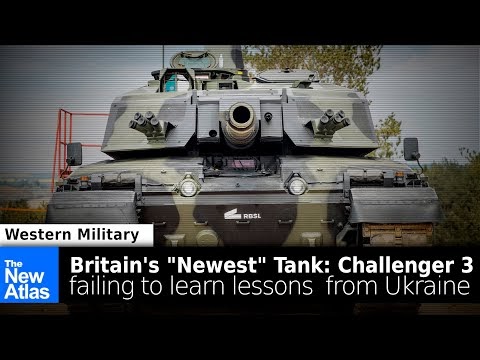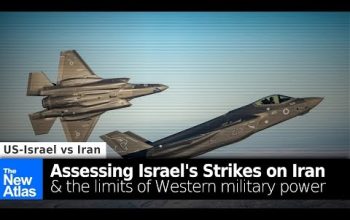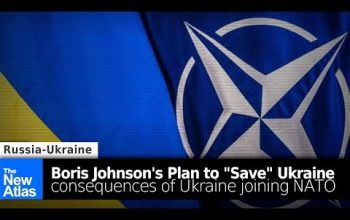April 29, 2024 (NEO – Brian Berletic) – The United Kingdom’s Ministry of Defense announced that the “UK’s most lethal tank” has rolled off the production line. The same statement would claim that British Army soldiers are “one step closer to getting their hands on one of Europe’s most lethal tanks – the Challenger 3.”
However, with few exceptions, the details of the Challenger 3 main battle tank produced under a nearly $990 million contract with Rheinmetall BAE Systems provides only the latest example of Western military industrial production emphasizing profit over purpose and demonstrating that the British government and armed forces have failed to learn key lessons from the ongoing conflict in Ukraine.
The Challenger 3 is not Really “New”
While the initial announcement and price tag suggests the Challenger 3 is a newly produced tank, it is, in fact, the refurbishment and modernization of existing Challenger 2 tanks.
The BBC, in an April 2024 article titled, “UK’s most lethal tank enters testing,” would claim the British army’s existing 221 Challenger 2 tanks will be “slimmed down” to 127 refurbished/modernized Challenger 3s. The Ministry of Defense’s statement claims up to 148 Challenger 3’s will be handed over in total.
Despite being refurbished and modernized from existing tanks, the $990 million program equates to about $6-8 million per tank, which is several times more expensive than refurbished/modernized Russian T-72B3, T-90M, or T-80BVM tanks, and almost as expensive as Russia’s newest tank, the T-14 Armata which is believed to cost between $5-9 million according to a recent Business Insider article.
Refurbished and modernized main battle tanks can still perform effectively on the battlefield. A tank’s most important characteristics are its firepower, protection and mobility, all of which are often upgraded during modernization programs.
Russia has proven refurbishment and modernization programs can field large quantities of effective armor on the battlefield, but the key to the success of such programs is that the process is done quickly and cheaply. Novaya Gazeta, a Western-funded media platform, in a November 2022 article titled, “The barren barrels,” would claim that Russia’s tank industry was capable of producing up to 250 new vehicles and modernizing up to 600 more a year. This is a vastly larger quantity than the total planned number of all Challenger 3 tanks until the year 2040.
Doubling Down on an Obsolete Design Philosophy
There is no evidence that Britain’s Challenger 3 tanks can justify their high price and low quantity. No matter how effective the tanks are, their small numbers will put them at a disadvantage in any large-scale operation with a peer or near-peer adversary.
The Challenger 2 main battle tank, upon which the Challenger 3 is based, was already put to the test and performed poorly in Ukraine. Because of the overall small number of Challenger 2s in the UK’s inventory, only 14 could be transferred to Ukrainian forces for use in combat. In September 2023 amid Ukraine’s failing offensive, British media reported the first Challenger 2 destroyed by Russian forces, likely by a mine.
While there was speculation that Ukraine was holding its Challenger 2 tanks in reserve for a “breakthrough” amid its 2023 offensive, no such operation took place.
Instead, reports claimed the Challenger 2 was being used as an expensive, heavy, and overly complex assault gun to attack frontline fortifications. Similar reports criticized the Challenger 2 as being “too heavy,” lacking protection, and needing “too much support.” Its heavy weight combined with a relatively underpowered engine reportedly rendered the tank immobile in Ukraine’s muddy terrain. The weight also poses problems in traversing bridges across the battlefield unable to support the tank.
Other Western main battle tanks using similar design philosophies suffered the same setbacks.
And like other Western main battle tanks, many systems on the Challenger 2 were unnecessarily complex. The tank uses hydropneumatic suspension instead of torsion bars like most modern tanks. The complex system of suspension supposedly improves the accuracy of the main gun. The added complexity of the suspension meant more complex maintenance was required along with a larger number of replacement parts for repairs, complicating Ukraine’s already dire logistical challenges.
Because the Challenger 2 used a unique rifled main gun as opposed to 120mm smooth bore guns used by other NATO tank designs, a separate supply of ammunition was required, making it even more difficult to sustain the tank on the battlefield.
The Challenger 3 is actually heavier than the Challenger 2 but is expected to use an engine of similar size and power, meaning that traversing difficult terrain will be even more problematic, as will finding bridges capable of supporting the extra weight. The Challenger 3 will be using an upgraded version of the complex hydropneumatic suspension of the Challenger 2.
One design decision that is an overall improvement is the use of a 120mm smooth bore gun allowing the Challenger 3 to use NATO standard ammunition, easing the logistical burden of upgraded tanks on a joint-operation exercise or battlefield.
Overall, the Challenger 3 represents the doubling down on an obsolete design philosophy, where smaller numbers of complex tanks were meant to gain an advantage over lower quality but more numerous enemy counterparts. Today, modern Russian main battle tanks are just as capable of firing over a range of several kilometers and hitting their target on the first shot. Because Russian main battle tanks also fire anti-tank guided missiles (ATGMs) from their main guns, they can actually engage targets outside the range of Western tanks.
But as Ukraine has proven, tank-on-tank combat is relatively rare. Both sides use highly portable ATGMs mounted on a wide range of mobile platforms, and kamikaze drones in the anti-tank role. Tanks are instead used in assaults on enemy defenses and as long-range direct fire weapons. Neither of these roles require the expensive and complex features included in either the Challenger 2 or 3’s designs.
Instead, because of the greater likelihood that main battle tanks will be hit and either severely damaged or destroyed, the nation capable of producing effective tanks the fastest and cheapest gains an advantage in what is essentially a strategy of attrition.
The Challenger 3 represents a complete failure to learn any of these lessons.
The Challenger 3 along with its other Western counterparts including the American M1 Abrams and the German Leopard 2, represent an approach developed during decades of “small wars” using combined arms against poorly organized and inadequately armed militants. Even in that role, the West’s large, heavy, complex design philosophy began to fall prey to cheap and effective Russian ATGMs proliferating across the world’s battlefields.
The motivation to continue building upgraded versions of these large, complex, expensive main battle tanks stems mainly from a desire for financial profit rather than a focus on battlefield effectiveness. Developing an entirely new main battle tank requires large sums of money for research and development as well as new tooling to eventually manufacture them that could be pocketed by doing far less extensive (but also far less effective) upgrades to existing tanks no matter how inappropriate they are on the modern battlefield.
The BBC in its article would quote Defense Secretary Grant Shapps regarding the rollout of the first Challenger 3s, saying:
In a more dangerous world, the need for vehicles such as the Challenger 3 is imperative, as the threats facing the UK evolve.
However, the many wars and proxy wars the UK and its American and European allies have fought over the past two decades have all been conflicts of choice – interventions often sold to the public based on deliberate lies regarding “threats” that the collective West supposedly faced.
In reality, it is this profit-over-purpose mindset diverting public resources from infrastructure, education, and healthcare to overpriced, useless weapons programs like the “imperative” Challenger 3 that pose the greatest threat to the welfare and happiness of the Western public.
Brian Berletic is a Bangkok-based geopolitical researcher and writer, especially for the online magazine “New Eastern Outlook”.



